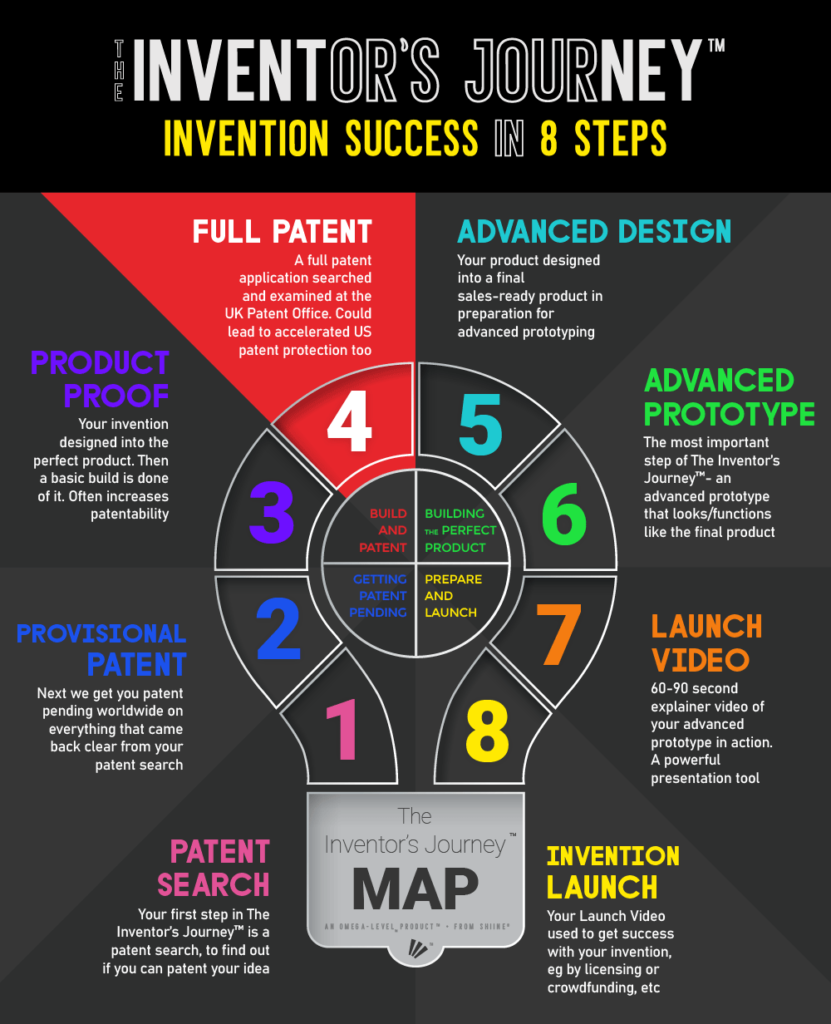DEADLY MISTAKE #5
GETTING EXPENSIVE SERVICES BEFORE A FULLY DESIGNED PROTOTYPE OF YOUR PRODUCT
The Dreaded ‘Double-Pass’ Of Your Patenting
You already know that your invention will needs to be designed into the BEST POSSIBLE VERSION of your product concept, to have the best chance to win. But what you may not know is that it’s IMPERATIVE that this happens BEFORE you file your full (non-provisional) patent application.
Why?
Because if you only get this done AFTER you’ve filed your full patent application, you will not be able to ‘add’ the changes to the product into your patent application, so the only way you’ll be able to patent those extra/different features that happen, (which often may be very important from a patenting point of view), will be to file yet another whole non-provisional patent application. And this can often take just as much work and time as the FIRST non-provisional patent application that you had drafted, filed and paid for. Worse still, you may have to pay a similar amount all over again. In some cases, it may even be that your first non-provisional patent application, (which you paid thousands of dollars for), becomes REDUNDANT, (ie useless). This actually happened to me the first time I tried to patent Discshine™ and it’s more likely to happen than you think.
I call this the dreaded ‘double-pass’, where you end up having to go through the patenting process more than once. It’s an absolute nightmare. You need to avoid it at all cost.
And there’s another thing that goes hand-in-hand that’s very important for you to know about:
Having a Perfectly Designed Proof Of Principle Prototype Before Filing Your Non-Provisional Patent Application
There’s no legal requirement that you have to have a prototype built before applying to get a patent. But here’s the problem- to have the best possible chance of getting all the information you want and need into your non-provisional patent application, you need to not only have your invention designed into the ‘perfect version’ of your product concept, but you need to at least have had a proof-of-principle prototype made. Why? Because, (and I can tell you this as a product designer who does a lot of prototyping via 3D printing and also as someone who’s effectively been a patent practitioner for the last 13-14 years), beautiful and strange surprises and problems often come up during the prototyping process that have big and important impacts on not only the DESIGN of your product, but therefore on the PATENTING of your product. I often encounter PROBLEMS in the design of the product during the physical prototyping, and SOLVING these problems often creates incredibly important patentable material. In fact, it often uncovers inventive steps that in-and-of-themselves can either get you PERFECT patent protection, or become highly important independent claims/patents that hugely add to the patenting strategy of your invention.
The bottom line is, you need, (ideally), perfect design, and then to go through the incredible process of proof-of-principle prototyping of that ‘perfect design’, to get to the end of the physical process of having solved all problems with the product design, with all the benefits of all the new patentable material that may well have been generated by this process.
Only THEN do you want to get expensive services like your non-provisional patent application being drafted and filed at the patent office, because if you get your patent application done BEFORE unearthing all that new patentable material of the ‘perfect design’ and its prototyping, your only way to be able to patent all that new stuff, (and not ultimately just lose the right to patent it after disclosing/releasing your product), will be to do the dreaded ‘double-pass’ of your patenting, where you’ll have to have a SECOND non-provisional patent application drafted and filed at the patent office, with all the horrible expense, time, and effort that goes into that. For some inventors, that’s just too much expense, and this issue could leave your project stymied and stuck with you not wanting to move ahead and lose the ability to patent all the new inventive features that are in your finished design, but NOT in the first non-provisional patent application you had filed.
You May Have to start the process again, from scratch
If you don’t do at least a proof-of-principle prototype before your non-provisional patent application is drafted (and before other expensive services such as ‘3D presentation graphics), in extreme cases, (like with my invention Discshine™ when I went to that ‘invention help’ company), you may lose all your money and have the start the process right from the beginning.
You’ll see me explain this in the video for this Deadly Mistake. Basically, the ‘invention help’ company did an expensive ‘3D presentation graphics’ service and then sent me off to a patent attorney to get a full non-provisional patent application drafted and filed, based completely off the graphics they had done. (The patent attorney actually used their graphics as the drawings of the patent application). But when they then did just a £500 service of building a basic motor-driven shoe cleaning device, they found out that Discshine™ needed a much bigger motor than the ultra-flat design in their expensive presentation graphics. It meant Discshine had to be fully re-designed, and that the expensive graphics were now not fit for presentation. (ie Useless). Worse still, it ultimately meant I had to withdraw the patent application and start from the beginning of the process again. You need to avoid this at all cost.
Look at the SOLUTION tab below for how to avoid this. I’ve designed The Inventor’s Journey™ to make this structurally impossible, if the elite designers who design your invention into the perfect version of the product do their job.
Perfect Design + Prototype before any other expensive services- Especially Full (Non-Provisional) Patent Application
The solution, of course, is to have your invention designed into the perfect version of the product, and then get THAT prototyped BEFORE getting any other expensive services, especially having a full non-provisional patent application drafted and filed. This is the essence of our PerfectProduct™ Proof Of Principle service at step 3 of The Inventor’s Journey™. (See breakdown below).
This is one thing I really love about The Inventor’s Journey™ and I think you will too. If you look at The Inventor’s Journey™ Map below, you’ll see that step 4 (Full Patent), where one of our patent practitioners will draft, filed and prosecute a full non-provisional patent application for you at the patent office, is AFTER step 3 (Product Proof-of Principle Prototype):

This is absolutely KEY for your invention, because we really focus on designing your invention concept into the perfect version of the product, and then PROTOTYPING it, (to unearth and generate all the patentable material possible that often comes out of the design and prototyping phase), before we file your non-provisional patent application. This is huge for you because it means the following 3 things are the case:
- It is highly likely we’re going to generate NEW PATENTABLE MATERIAL during the design and prototyping process, all of which can then be included in your final non-provisional patent application, potentially hugely increasing the patentability of your invention
- It makes it as unlikely as possible that you’ll have to do the dreaded ‘double-pass’ of your patenting- having to file multiple non-provisional patent applications when you could have got all the information about your invention in just ONE if you had done things in the right order
- You won’t waste money on unnecessary ‘presentation graphics’ because we don’t do them- they’re far less useful than many companies will try to tell you they are!! (It’s not that we can’t do them- I used to provide these services and actually made much more complicated animated 3D graphical videos of products I designed. But those services are not as important as prototyping and ultimately having a video of advanced prototype, (which we do at step 7). This is why those services are not part of the Inventor’s Journey™.
Incidentally, you’ll also notice that The Inventor’s Journey™ PROOFS you against losing a huge amount of money like I did with that ‘invention help’ company with Discshine™, because the 2 services we have before the Proof-of-principle prototype step at step 3 are both relatively inexpensive. So whereas I lost around $6000 back around 2008, (which would probably be more like $8000 with inflation and how expensive the world has become…), if the exact same thing happened with you, you would lose less than $2000. This is just another way that the ORDER and STRUCTURE of The Inventor’s Journey™ makes things far less dangerous for you, from a financial point of view.
The PerfectProduct™ Proof of Principle Service
Breakdown
DESIGN PHASE
1. Creating the ‘Perfect’ Design
DESIGN PHASE
2. Presenting you with the ‘Perfect’ Design
Prototype Phase
3. Execution of the Proof of Principle Prototype of the Perfect Design

All rights reserved.